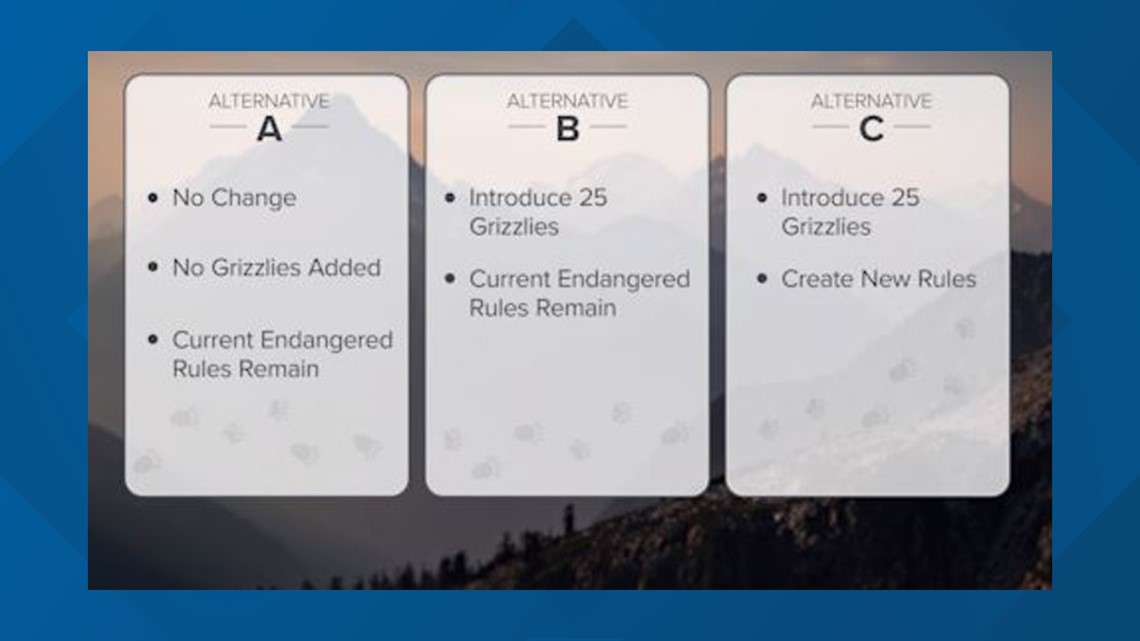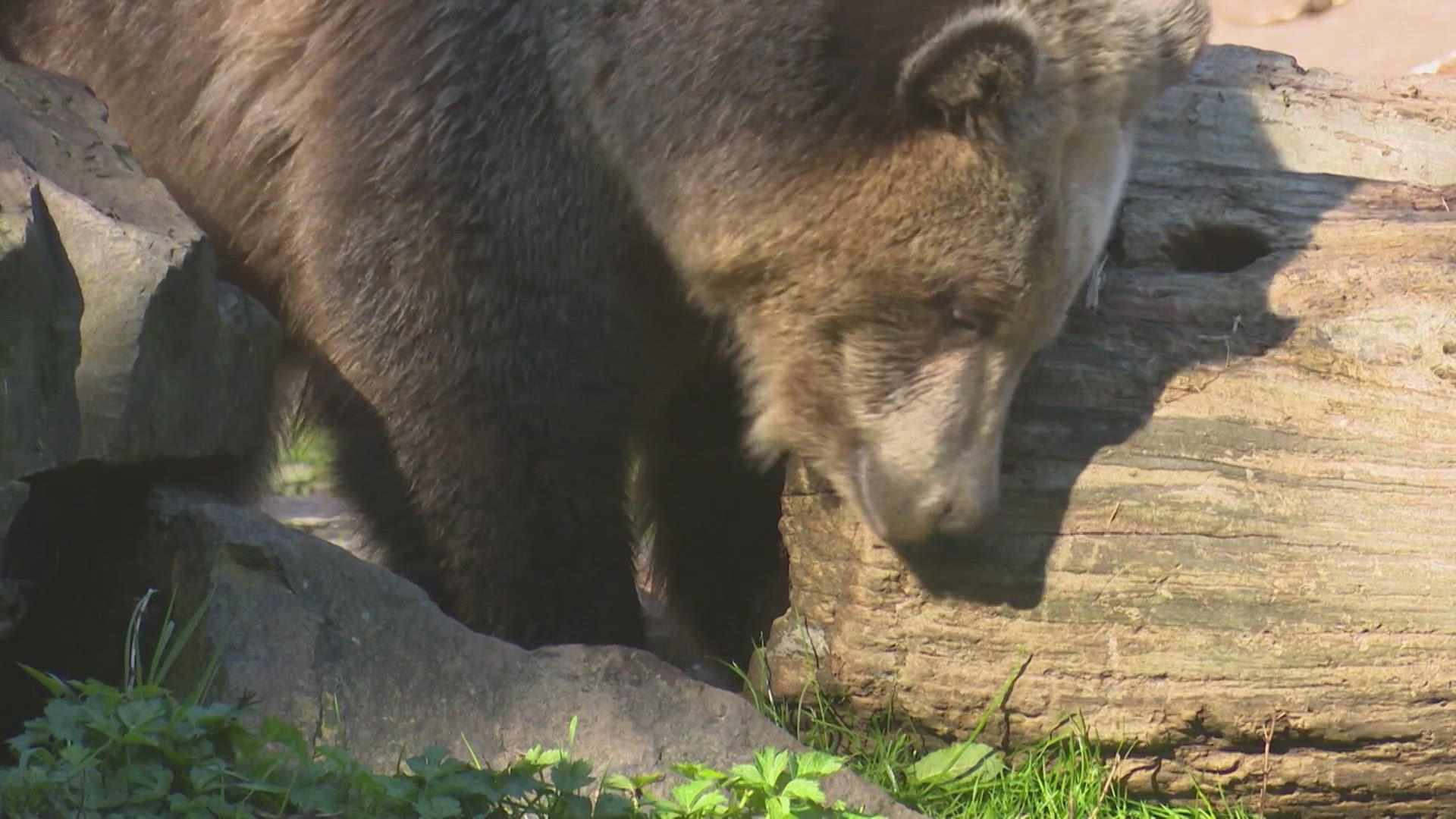NEWHALEM, Wash. —
While Washington leaders are deciding whether or not to bring back grizzly bears to the United States' side of the North Cascades, plans are moving forward to bring grizzly bears back to the North Cascades in British Columbia.
It's been decades since grizzlies called the mountain range home and due to the species endangered species status, federal mandates require former habitats be considered for rehabilitation. Washington is one of those regions and has three potential outcomes on the table.
The first alternative, "Alternative A," would make no changes. No grizzly bears would be added to the North Cascades in Washington, and the current endangered species rules stay in place. Currently, landowners can only kill grizzlies if human life is threatened – not animals or livestock.
"Alternative B" and "Alternative C" would gradually bring 25 bears through a multi-year span. Ultimately, the goal would be to grow to 200 bears, which could take 60 to 100 years.
Alternative B would keep the current endangered species rules in place, while Alternative C would create new rules, called a 10j.
The 10j gives leaders the chance to create their own rules. One major change under Alternative C would give landowners more rights to protect their animals if other preventative steps have been taken with fish and wildlife.
"In certain circumstances, we could issue a lethal take permit to a landowner to kill a grizzly bear that has been offending by taking livestock," said Wayne Kasworm, with the U.S. Fish and Wildlife Grizzly Recovery Program.
Under the Endangered Species Act, the 10j rule is only possible if a population has not been established, which is currently the case. However, when plans move forward to bring grizzlies to the North Cascades in British Colombia, that will likely change.


Cailyn Glasser, Okanagan Nation Alliance Natural Resource manager, said British Columbia made a formal declaration to implement the Declaration on the Rights of Indigenous Peoples Act (DRIPA) in all legislation. In 2014, Glasser said their chiefs declared grizzlies protected and mandated their organization to protect them, especially in the North Cascades.
British Columbia is in the developmental stages of its strategy with the goal to finish by this winter. This means grizzlies could be on the Canadian side of the North Cascades as early as 2024.
“Our nation, the Syilx nation has always recognized grizzly bears as protected and sort of a cornerstone, a pillar of cultural integrity and landscape and ecosystem health," Glasser said.
The British Colombia leaders will be moving forward, regardless of what U.S. leaders decide to do in Washington.
"Some of those bears will certainly find their way south and we will have them in this ecosystem. So the question is not so much if we want to have bears here because bears will probably find their way here, it’s what tools do we want to have to coexist with them," said Jason Ransom, Wildlife Program Supervisor for the North Cascades National Park.
Grizzlies will end up in the United States eventually, Glasser agreed.
"They're going to travel across the border," Glasser said. "That's a given. We know that. So timing-wise, it depends on what kind of planning we can do as a transboundary team."
Both Glasser and Ransom said the two countries and regions are in contact, but would not make or change a decision based on the other country.
This means that once grizzlies cross the border and settle, that 10j rule will not be able to be implemented, because it's only applicable if a population has not been established. Agencies will lose the management tools as part of the Endangered Species Act if a population settles in the country.
Grizzly bears have existed in the North Cascades ecosystem for thousands of years, according to the NPS. However, in the 1800s, they were hunted and most of the population was killed by 1860. This led to the now state-designated endangered listing of the grizzly bear. A federal mandate made it a requirement to help the bear population recover.
From around 2005 to 2015, only two grizzly bears were identified in the North Cascades ecosystem in British Columbia. The last time a grizzly bear was confirmed in U.S. territory of the North Cascades ecosystem was in 1996.
Fish and wildlife’s Wayne Kasworn said it’s the grizzly bears' past here that makes this a considered place to nurse the species back to health – after being declared endangered in 1975.
"Largely because of the National Parks, the wilderness areas, the history of bears here, we have a significant opportunity to recover bears in this area," Kasworn said.
In parts of the United States where thousands of bears live and millions of people visit, there are only seven bear attacks on people yearly - with less than one resulting in death.
Now, state leaders are seeking the public's opinions. Public comment is open through November 13. The Department of Interior will then take the community's feedback and make a decision.
State leaders have hosted public listening sessions in the general area to get feedback. One meeting in the small town of Newhalem brought a few dozen citizens, where people gave input on the decades-long controversy.
"I am of the firm belief that humans and grizzlies can get along together," one citizen said in support of the plan to bring them back.
"These are people that farm, people that have cattle, people that have children, people that recreate here," said another who is against bringing grizzlies back because of the risk he fears it puts on people living in the area.
Robert Long, Living Northwest Conservation Program Director at Woodland Park Zoo, said bears and humans already co-exist in the wild right now.
"People in Washington, especially people in the Cascades, tend to live and hike with bears all the time," Long said. "They're black bears. And a lot of the things you would tend to do to make sure you’re hiking or living safely among black bears is the same thing with grizzly bears."
Long said there are two brown bears at the Woodland Park Zoo, but only one is considered a grizzly. He said a grizzly bear is named for where it's from. Fern came from Montana, making her a grizzly bear. Jupiter is from Alaska and was raised on a fish-rich diet, making her a coastal brown bear. The coastal bears can be much larger because of the fat-rich diets from fish.
For most grizzly bears, including the bears that would be in the Cascades, the bulk of diets consist of berries.
Washington's report shows that in Montana, grizzlies killed an average of 65 cattle and 34 sheep each year from 2019-2022, but there are thousands of bears living there.
The report estimates that 25 grizzlies in the North Cascades could kill up to three cattle and one sheep per year.
Long said he supports the restoration of grizzlies to the Cascades because we are the reason they’re not here.
"I think we really have a responsibility to try to restore species that we have helped make extinct in a local area or extirpated from a local area," Long said.
The period for public comments was open for 45 days and closes Nov. 13. You can make a comment here.
All comments will be reviewed and a final decision is expected to be made by next spring.

